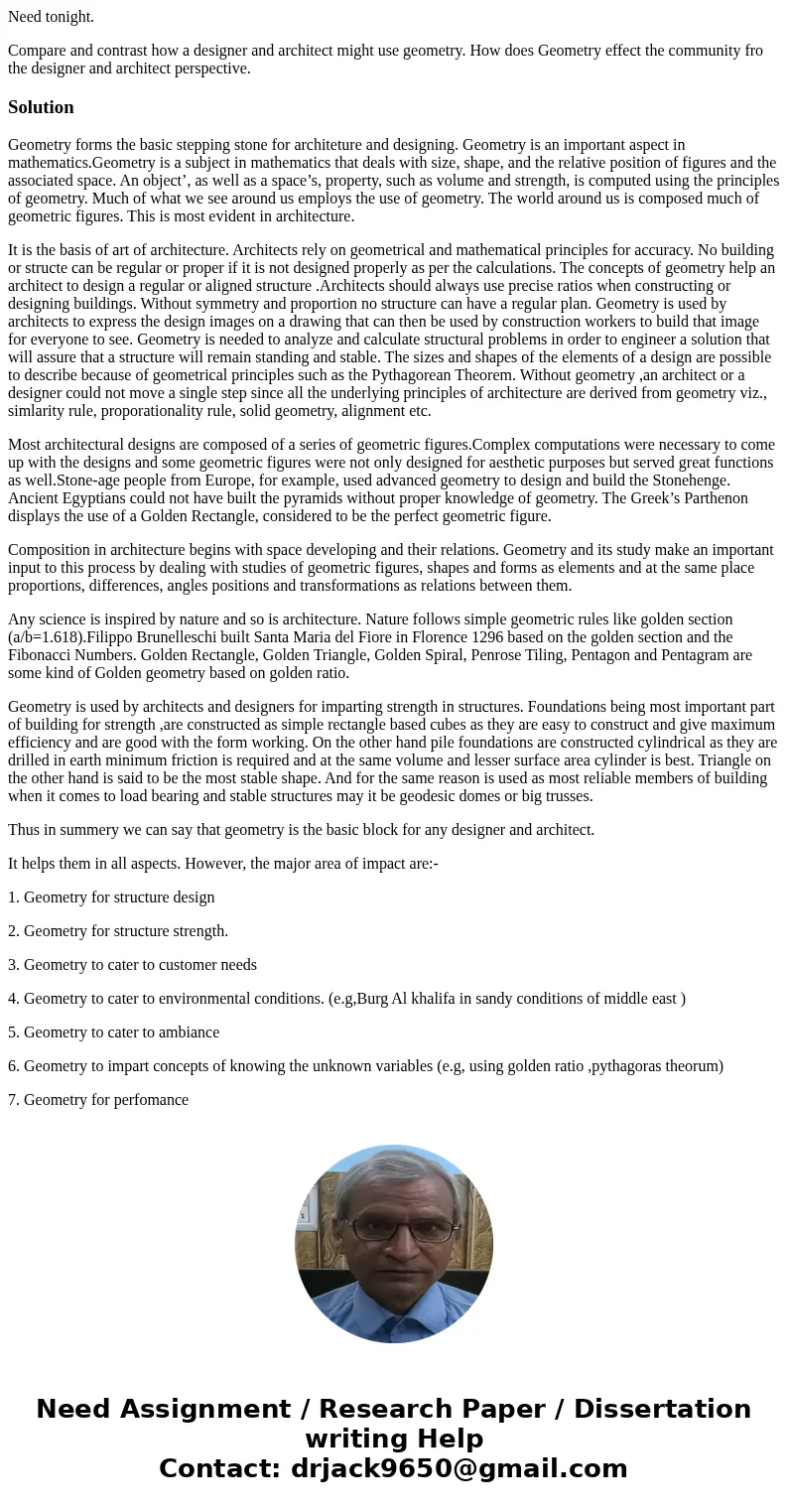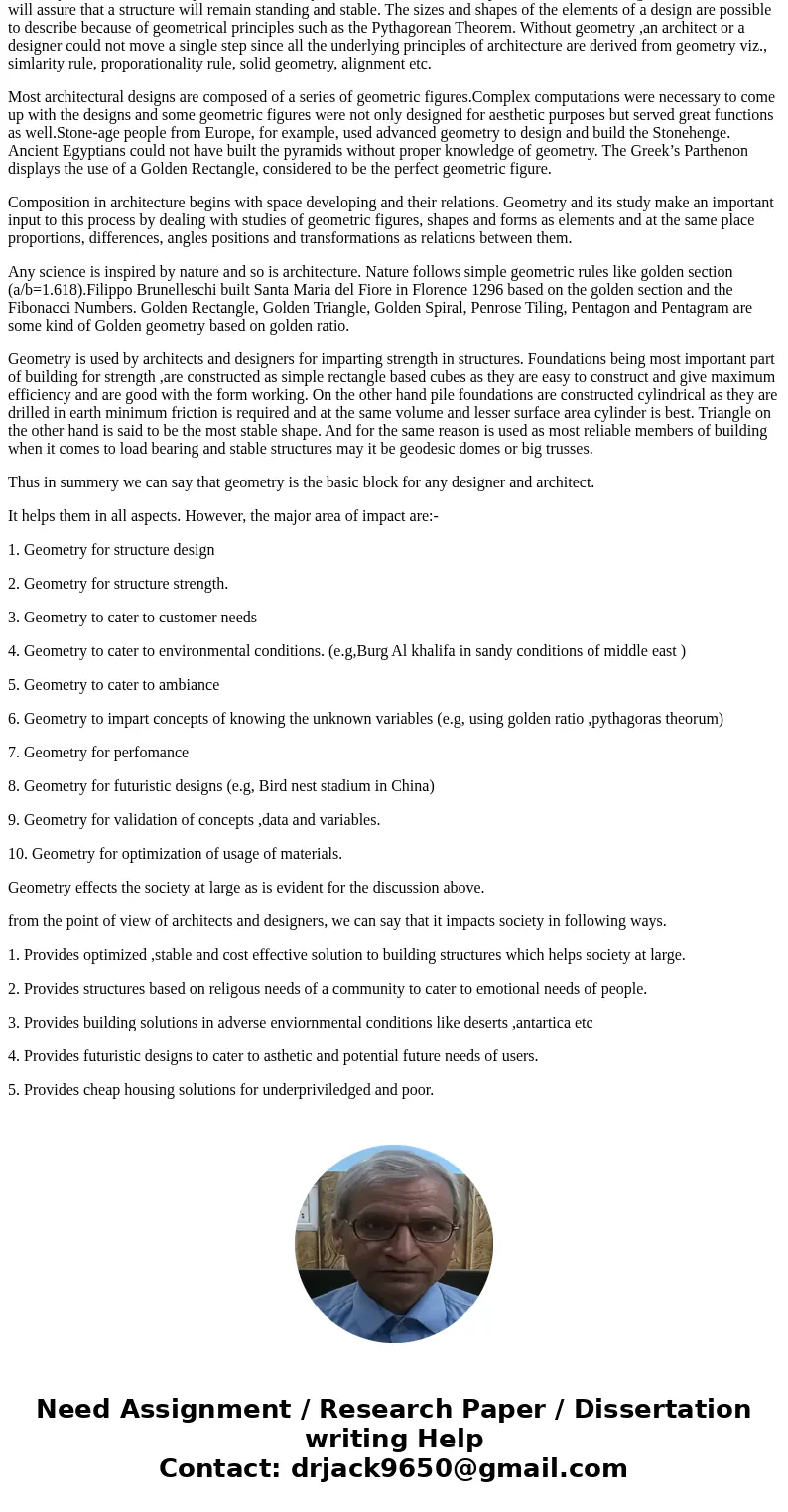Need tonight Compare and contrast how a designer and archite
Need tonight.
Compare and contrast how a designer and architect might use geometry. How does Geometry effect the community fro the designer and architect perspective.
Solution
Geometry forms the basic stepping stone for architeture and designing. Geometry is an important aspect in mathematics.Geometry is a subject in mathematics that deals with size, shape, and the relative position of figures and the associated space. An object’, as well as a space’s, property, such as volume and strength, is computed using the principles of geometry. Much of what we see around us employs the use of geometry. The world around us is composed much of geometric figures. This is most evident in architecture.
It is the basis of art of architecture. Architects rely on geometrical and mathematical principles for accuracy. No building or structe can be regular or proper if it is not designed properly as per the calculations. The concepts of geometry help an architect to design a regular or aligned structure .Architects should always use precise ratios when constructing or designing buildings. Without symmetry and proportion no structure can have a regular plan. Geometry is used by architects to express the design images on a drawing that can then be used by construction workers to build that image for everyone to see. Geometry is needed to analyze and calculate structural problems in order to engineer a solution that will assure that a structure will remain standing and stable. The sizes and shapes of the elements of a design are possible to describe because of geometrical principles such as the Pythagorean Theorem. Without geometry ,an architect or a designer could not move a single step since all the underlying principles of architecture are derived from geometry viz., simlarity rule, proporationality rule, solid geometry, alignment etc.
Most architectural designs are composed of a series of geometric figures.Complex computations were necessary to come up with the designs and some geometric figures were not only designed for aesthetic purposes but served great functions as well.Stone-age people from Europe, for example, used advanced geometry to design and build the Stonehenge. Ancient Egyptians could not have built the pyramids without proper knowledge of geometry. The Greek’s Parthenon displays the use of a Golden Rectangle, considered to be the perfect geometric figure.
Composition in architecture begins with space developing and their relations. Geometry and its study make an important input to this process by dealing with studies of geometric figures, shapes and forms as elements and at the same place proportions, differences, angles positions and transformations as relations between them.
Any science is inspired by nature and so is architecture. Nature follows simple geometric rules like golden section (a/b=1.618).Filippo Brunelleschi built Santa Maria del Fiore in Florence 1296 based on the golden section and the Fibonacci Numbers. Golden Rectangle, Golden Triangle, Golden Spiral, Penrose Tiling, Pentagon and Pentagram are some kind of Golden geometry based on golden ratio.
Geometry is used by architects and designers for imparting strength in structures. Foundations being most important part of building for strength ,are constructed as simple rectangle based cubes as they are easy to construct and give maximum efficiency and are good with the form working. On the other hand pile foundations are constructed cylindrical as they are drilled in earth minimum friction is required and at the same volume and lesser surface area cylinder is best. Triangle on the other hand is said to be the most stable shape. And for the same reason is used as most reliable members of building when it comes to load bearing and stable structures may it be geodesic domes or big trusses.
Thus in summery we can say that geometry is the basic block for any designer and architect.
It helps them in all aspects. However, the major area of impact are:-
1. Geometry for structure design
2. Geometry for structure strength.
3. Geometry to cater to customer needs
4. Geometry to cater to environmental conditions. (e.g,Burg Al khalifa in sandy conditions of middle east )
5. Geometry to cater to ambiance
6. Geometry to impart concepts of knowing the unknown variables (e.g, using golden ratio ,pythagoras theorum)
7. Geometry for perfomance
8. Geometry for futuristic designs (e.g, Bird nest stadium in China)
9. Geometry for validation of concepts ,data and variables.
10. Geometry for optimization of usage of materials.
Geometry effects the society at large as is evident for the discussion above.
from the point of view of architects and designers, we can say that it impacts society in following ways.
1. Provides optimized ,stable and cost effective solution to building structures which helps society at large.
2. Provides structures based on religous needs of a community to cater to emotional needs of people.
3. Provides building solutions in adverse enviornmental conditions like deserts ,antartica etc
4. Provides futuristic designs to cater to asthetic and potential future needs of users.
5. Provides cheap housing solutions for underpriviledged and poor.


 Homework Sourse
Homework Sourse